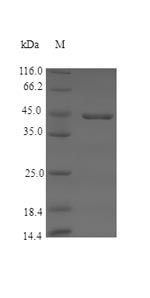Recombinant Pig Coagulation factor XII (F12) is produced in an E.coli expression system, featuring a partial protein length from amino acids 20 to 371. The protein carries an N-terminal 6xHis tag, which streamlines purification and detection processes. SDS-PAGE analysis confirms the product achieves over 90% purity, making it appropriate for research applications. This product is intended for research use only.
Coagulation factor XII represents a crucial component of the coagulation cascade. It appears to primarily drive the initiation of the intrinsic pathway. This serine protease likely plays a significant role in hemostasis by activating factor XI and prekallikrein. Studying this factor may be important for understanding blood clotting disorders and developing therapeutic interventions. Many researchers turn to factor XII when investigating thrombosis and inflammation.
Potential Applications
Note: The applications listed below are based on what we know about this protein's biological functions, published research, and experience from experts in the field. However, we haven't fully tested all of these applications ourselves yet. We'd recommend running some preliminary tests first to make sure they work for your specific research goals.
The porcine factor XII is a complex serine protease zymogen whose bioactivity critically depends on correct tertiary structure formation, including specific disulfide bond patterns and potential glycosylation modifications. E. coli, as a prokaryotic expression system, lacks the eukaryotic chaperones and post-translational modification machinery necessary for proper folding of complex plasma proteins. While the partial sequence (20-371aa) may contain protease domains, independent expression in E. coli is highly unlikely to yield a correctly folded, bioactive protein due to the absence of proper disulfide bond formation and glycosylation.
1. Antibody Development and Validation
This recombinant protein can be used as an immunogen to generate antibodies against porcine F12, as antibodies can recognize linear epitopes. The high purity helps minimize antibodies against contaminants. However, antibodies produced may not recognize native, correctly folded F12 (e.g., in porcine plasma) due to altered conformational epitopes. Antibody specificity must be validated using native F12 purified from porcine plasma before applications like Western blot or ELISA.
2. Biochemical Characterization and Structural Analysis
The protein is suitable for basic biophysical characterization (e.g., circular dichroism for secondary structure, dynamic light scattering for aggregation state). Such studies are valuable for understanding the folding challenges encountered during E. coli expression. However, it is not suitable for high-resolution structural studies (e.g., X-ray crystallography) aimed at understanding the structure-function relationship of native F12.
3. Comparative Species Analysis
This protein can be used to compare physicochemical properties (e.g., molecular weight, theoretical pI, thermal stability) with F12 from other species. However, because it is likely misfolded, any comparison of functional properties (e.g., enzymatic activity, substrate specificity) is invalid. Meaningful cross-species functional comparisons require bioactive protein samples.
Final Recommendation & Action Plan
Given the structural complexity of Factor XII and the limitations of the E. coli expression system, this recombinant protein is highly unlikely to be bioactive and must not be used for functional studies (e.g., coagulation assays or interaction studies). The first step is to experimentally assess its folding state using techniques like non-reducing SDS-PAGE or Ellman's assay to check disulfide bond formation, and circular dichroism to analyze secondary structure. If misfolding is confirmed, its only reliable application is as an immunogen for antibody production, but resulting antibodies must be rigorously validated against native F12. For any research requiring functional F12, alternative expression in mammalian systems (e.g., HEK293 or CHO cells) is strongly recommended to obtain properly folded and modified protein.






